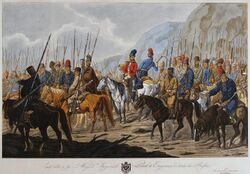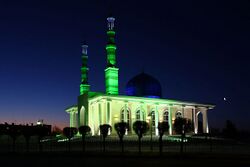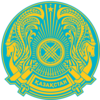أورال، قزاقستان
Oral
| |||
|---|---|---|---|
City | |||
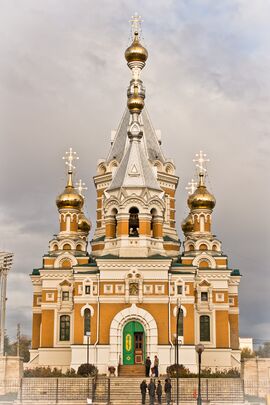 | |||
| الإحداثيات: 51°13′21″N 51°22′21″E / 51.22250°N 51.37250°E | |||
| Country | Kazakhstan | ||
| Region | West Kazakhstan Region | ||
| Founded | 1584 | ||
| Incorporated (city) | 1613 | ||
| الحكومة | |||
| • Akim (mayor) | Mirzhan Satkanov | ||
| المساحة | |||
| • City | 700 كم² (300 ميل²) | ||
| المنسوب | 35 m (115 ft) | ||
| التعداد (2019) | |||
| • City | 330٬000 | ||
| • الكثافة | 470/km2 (1٬200/sq mi) | ||
| • Urban | 234٬184 | ||
| منطقة التوقيت | UTC+5 (UTC+5) | ||
| Postal code | 090000 - 090013 | ||
| مفتاح الهاتف | +7 7112 [1] | ||
| لوحة السيارة | L, 07 | ||
| الموقع الإلكتروني | uralsk | ||
| |||
Oral (قزخ: Орал, pronounced [ɔɾɑɫ] (![]() استمع)), known in Russian as Uralsk (روسية: Уральск), is a city in northwestern Kazakhstan, at the confluence of the Ural and Chagan rivers close to the Russian border. As it is located on the western bank of the Ural river, it is considered geographically in Europe. It is the capital of the West Kazakhstan Region. The ethnic composition is dominated by Kazakhs (71%) and Russians (25%). Population: 271,900 (نتائج تعداد 2009);[2] 194,905 (نتائج تعداد 1999).[2]
استمع)), known in Russian as Uralsk (روسية: Уральск), is a city in northwestern Kazakhstan, at the confluence of the Ural and Chagan rivers close to the Russian border. As it is located on the western bank of the Ural river, it is considered geographically in Europe. It is the capital of the West Kazakhstan Region. The ethnic composition is dominated by Kazakhs (71%) and Russians (25%). Population: 271,900 (نتائج تعداد 2009);[2] 194,905 (نتائج تعداد 1999).[2]
. . . . . . . . . . . . . . . . . . . . . . . . . . . . . . . . . . . . . . . . . . . . . . . . . . . . . . . . . . . . . . . . . . . . . . . . . . . . . . . . . . . . . . . . . . . . . . . . . . . . . . . . . . . . . . . . . . . . . . . . . . . . . . . . . . . . . . . . . . . . . . . . . . . . . . . . . . . . . . . . . . . . . . . .
التاريخ
In the 13th century, on the Svistun hill, 12 km from modern Uralsk, there was a Golden Horde settlement Zhaiyk , the remains of which were discovered during excavations. The name of the settlement was conditionally assigned to the Kazakh name of the river. Research has shown that it was a large city that arose during the heyday of the Golden Horde in the 13th-14th centuries. Residential estates, outbuildings, kilns for brick production and a bathhouse - hammam - were discovered in the city . At the site of the city, 2 large mausoleums were also discovered. In connection with the fall of the Golden and Nogai Hordes , the city lost its importance, handicraft production and trade began to decline [8] .
During the Kazakh-Nogai war in the first quarter of the 16th century, Kasym Khan , having won a victory over the Nogai Horde , included these lands into the Kazakh Khanate for several years [9] [10] .
At the end of the 16th century, settlers from Russian lands appeared on the banks of the Urals, calling themselves Cossacks [8] .
In 1584, it was referred to as the Yaitsky town, which was founded in the Oreshnoye tract by the Yaitsky Cossacks , formed from the fugitive Volga Cossacks (their ataman Bogdan Barbosha is considered the founder of the Yaitsky town [11] ). After its destruction by the Nogais , in 1613 it was moved 50 km down the Yaik (Ural) River to its modern location [12] , and 1613 is considered the official founding date of the city. In 1988, the 375th anniversary of the city was widely celebrated. It was founded on a peninsula between the Yaik (Ural) and Chagan rivers. Now this area of the city is called “Kureni”, from the word kuren - a Cossack dwelling.
In 1591, the Yaik Cossacks accepted Russian citizenship , but until Peter I they had complete autonomy. In 1773-1775, the Yaik Cossacks became the core of the uprising of Emelyan Pugachev . After the defeat of the rebels in 1775, Empress Catherine II ordered to rename the Yaitsky town to Uralsk, and the Yaik River to the Ural.
However, unrest among the Cossacks took place more than once. This happened in 1804, 1825, 1837, 1874. All unrest was brutally suppressed by troops.
The main occupations of the city's residents were fishing , melon growing and cattle breeding . Red fish provided the main income for the city, and its entire life was built from one type of fishing to another.
The merchant class played a major role in the life of the city . There was a Tatar settlement in the city . The Tatars served in the army, many were officers, but their main occupation was trade. By the end of the 19th century, there were about 100 Tatar hereditary nobles in Uralsk, and out of 450 people belonging to merchant families, there were 300 Tatars. According to the All-Russian Census of 1897, 6,129 people in the city considered the Tatar language their native language. They made up a third of the population of Uralsk. The Tatars were a kind of connecting link between Russia and the nomadic clans of the Kazakhs. The first newspapers in the Kazakh language were printed in the Tatar printing houses of Uralsk.
In 1846, Uralsk was classified as a large city, becoming a major trading center.
In 1868, the city became the administrative center of the created Ural region and Ural district , the capital of the Ural Cossack army, and was part of the Orenburg province [13] .
On April 29, 1879, at one o'clock in the afternoon, the ringing of bells in all churches announced to the city about the fire, which by 5 o'clock in the evening of the same day destroyed up to 2/3 of the city. The fire started in Novosyolki, from the last house on the banks of the Urals, in the poorest part of the city, where the streets are no more than six arshins wide , house from house is separated only by a gate, the buildings are all exclusively wooden - this entire part, numbering about 2000 houses, is not In more than an hour it turned into a sea of fire. The wind was quite strong and uneven. There were moments when it calmed down, but again it appeared as a storm and a mighty hurricane. Having licked Novoselki, adjacent to the Urals, clean, the fire burst into the market square, and the shops with red goods standing here in several rows were enveloped in flames in a few minutes. At this terrible moment, in another part of the city, not at all in the path of the fire, more than a mile away from it, another fire broke out. In the house of the quarterly overseer Kurin. In a short time, both fires merged into one and a sea of flame, several blocks wide, along its path, driven by the wind, destroyed everything up to the Shagana River . The city turned into hell, the devastation was terrible. The extent of destruction is unknown in numbers. On the sides of the fire and in its rear, in the squares and along the streets, from the surviving and not surviving houses, property was hauled in carts and heaps, and, on this side, the city turned into a camp. Thousands of families were left without shelter and bread. Human efforts could not do anything. The sky was clear, without a cloud; but thick black smoke was so spread out in the air that in the parts free from the fire it was dark, as if in bad weather, the sun could not penetrate its rays for illumination. Uralsk does not know how to burn little by little, like other cities in Russia; since its founding. It burns for the third time within four centuries. But it burns to the ground, American style. It will take a hundred years for Uralsk to recover from this pogrom. Talk about arson with various options circulates among the people incessantly; they talk about the arrest and imprisonment of some dark personalities during the fire, but there is nothing reliable [14] .
In 1894, a railway was brought to Uralsk , which received the name Ryazansko-Uralskaya , which served as a great incentive for the further development of the city. In addition to the rapid emergence of manufactories and factories, a locomotive depot appeared.
At the beginning of the twentieth century, 39 thousand people lived in the city, mainly burghers , peasants, foreigners and other non-Cossack classes, mainly engaged in trade and agriculture. In terms of religion, Orthodox Christians predominated, but there were also a large number of Old Believers . There were 2 Orthodox and 10 Edinoverie churches, 3 mosques. Administratively, the city was divided into two villages : the first and second. The city was governed by a special council of military economic administration, which included, along with representatives of the Cossacks, representatives of the merchants and petty bourgeoisie. Stone buildings made up a significant part of the buildings, but the city did not have centralized water supply, sewerage or pavements.
Among the health care institutions at that time in the city there was a city military hospital with 100 beds, a free hospital and maternity hospital, a military almshouse and 2 pharmacies. Education was represented by a military women's eight-grade gymnasium, a military real school , a religious school and several elementary parish schools. Cultural institutions worth noting include a public library, two reading rooms, a theater and a printing house. The newspapers “Oblastnye Vedomosti”, “Voiskovye Vedomosti” and “Uralets” were published [13] .
Before the Civil War, the city had 15 Edinoverie and Orthodox parish and cathedral churches (4 more in the suburbs), 4 house churches, 4 mosques, several prayer houses (a significant part of the Ural Cossacks remained Old Believers of various accords - Beglopopovsky, chapel, Belokrinitsky).
During the Civil War, Uralsk was at the center of fierce fighting; occupied by the Bolsheviks in 1919, was subjected to a long siege by the Ural Army [15] .
During the Great Patriotic War, by the decision of the Military Council of the Stalingrad Front on October 16, 1942, Uralsk became a front-line zone and an air defense point for the country. 14 industrial enterprises working for the front, 20 military hospitals were evacuated to the city from the center, and military formations were formed.
Since December 1991 - part of independent Kazakhstan. In the 1990s, many streets in Uralsk that bore Russian and communist names were renamed.
In the fall of 2022, Uralsk, located near the border with Russia, became the most important transit point for refugees from Russia both deep into Kazakhstan and to other states.
الجغرافيا
المناخ
The climate of Oral is continental with long cold winters and warm, often hot summers. Under the Köppen climate classification, Oral has a cold semiarid climate (Köppen Bsk). Summers are extremely hot considering its position north of the 51st parallel, but winters are more reminiscent of continental climates further east than Europe.
| Climate data for أورال (1991–2020, extremes 1839–present) | |||||||||||||
|---|---|---|---|---|---|---|---|---|---|---|---|---|---|
| Month | Jan | Feb | Mar | Apr | May | Jun | Jul | Aug | Sep | Oct | Nov | Dec | Year |
| Record high °C (°F) | 6.6 (43.9) |
6.9 (44.4) |
22.1 (71.8) |
31.1 (88.0) |
37.8 (100.0) |
41.8 (107.2) |
42.0 (107.6) |
42.3 (108.1) |
38.8 (101.8) |
28.0 (82.4) |
18.0 (64.4) |
8.2 (46.8) |
42.3 (108.1) |
| Mean daily maximum °C (°F) | −6.7 (19.9) |
−5.9 (21.4) |
1.2 (34.2) |
14.7 (58.5) |
23.2 (73.8) |
28.1 (82.6) |
30.2 (86.4) |
29.0 (84.2) |
21.9 (71.4) |
12.5 (54.5) |
2.1 (35.8) |
−4.7 (23.5) |
12.1 (53.8) |
| Daily mean °C (°F) | −10.4 (13.3) |
−10.3 (13.5) |
−3.3 (26.1) |
8.3 (46.9) |
16.3 (61.3) |
21.1 (70.0) |
23.2 (73.8) |
21.5 (70.7) |
14.6 (58.3) |
6.7 (44.1) |
−1.6 (29.1) |
−8.2 (17.2) |
6.5 (43.7) |
| Mean daily minimum °C (°F) | −14.1 (6.6) |
−14.5 (5.9) |
−7.4 (18.7) |
2.6 (36.7) |
9.3 (48.7) |
13.9 (57.0) |
16.0 (60.8) |
14.2 (57.6) |
8.3 (46.9) |
2.1 (35.8) |
−4.7 (23.5) |
−11.6 (11.1) |
1.2 (34.2) |
| Record low °C (°F) | −43.1 (−45.6) |
−40.5 (−40.9) |
−35.2 (−31.4) |
−24.3 (−11.7) |
−6.8 (19.8) |
−1.1 (30.0) |
4.3 (39.7) |
0.4 (32.7) |
−7.6 (18.3) |
−19.2 (−2.6) |
−32.6 (−26.7) |
−39.2 (−38.6) |
−43.1 (−45.6) |
| Average precipitation mm (inches) | 25 (1.0) |
21 (0.8) |
25 (1.0) |
24 (0.9) |
32 (1.3) |
32 (1.3) |
39 (1.5) |
22 (0.9) |
27 (1.1) |
37 (1.5) |
27 (1.1) |
27 (1.1) |
339 (13.3) |
| Average extreme snow depth cm (inches) | 20 (7.9) |
29 (11) |
23 (9.1) |
2 (0.8) |
0 (0) |
0 (0) |
0 (0) |
0 (0) |
0 (0) |
0 (0) |
3 (1.2) |
10 (3.9) |
29 (11) |
| Average rainy days | 5 | 4 | 6 | 9 | 10 | 11 | 10 | 9 | 10 | 12 | 10 | 7 | 103 |
| Average snowy days | 20 | 16 | 10 | 2 | 0.2 | 0 | 0 | 0 | 0.1 | 3 | 11 | 18 | 80 |
| Average relative humidity (%) | 83 | 81 | 81 | 65 | 55 | 57 | 58 | 57 | 61 | 73 | 83 | 83 | 70 |
| Mean monthly sunshine hours | 84 | 120 | 165 | 227 | 314 | 304 | 324 | 293 | 220 | 136 | 64 | 65 | 2٬316 |
| Source 1: Pogoda.ru.net[3] | |||||||||||||
| Source 2: NOAA (sun, 1961–1990)[4] | |||||||||||||
النقل
السكك الحديدية
المطار
After reconstruction in the 1990s, Uralsk Airport received the status of an airport of international importance, located 16 kilometers from the city, near the suburban village of Podstepnoye .
In February 2023, the airport was acquired by Oral Airport Holding LLP [28] - this is a Kazakh company, the controlling stake of which belongs to the Kazakh Uralsk Management LLP and entrepreneur Dauletkhan Kilybaev, and a minority share (49%) is owned by the Russian company Retrans JSC " The company hopes to turn the Uralsk airport into a regional hub, expand the route network and carry out technical re-equipment of the airport [29]
On July 3, 2019, renovation work began to modernize the airport terminal. After modernization, passenger traffic will increase from 160 thousand to 350 thousand people, and the terminal area will increase from 4000 m² to 7500 m². According to the akim of the West Kazakhstan region, this value is not the limit, since the airport has a very favorable geographical location.
On March 18, 2022, the Government of Kazakhstan adopted a resolution naming the International Airport in Uralsk after Manshuk Mametova [30] .
On April 7, 2022, the airport opened after a complete reconstruction, which increased the terminal area from 4,000 to 10,000 m², as well as passenger traffic to 600,000 per year. The airport meets all international IATA standards . In the near future, it is planned to open new routes in the directions of Amsterdam , Moscow , Kiev , Istanbul , St. Petersburg , Abu Dhabi , Atyrau and Shymkent , as well as to increase the number of existing ones in Almaty, Frankfurt am Main, Astana, Aktau , Turkestan [31 ] .
After reconstruction of the runway, it is capable of receiving aircraft of the Il-76 , Boeing 737 , Boeing 757 types .
As of 2024, the airport operates flights to Frankfurt am Main , Aktau , Shymkent , Turkestan , Astana , Alma-Ata , شرم الشيخ، فوكـِت، أنطاليا.
. . . . . . . . . . . . . . . . . . . . . . . . . . . . . . . . . . . . . . . . . . . . . . . . . . . . . . . . . . . . . . . . . . . . . . . . . . . . . . . . . . . . . . . . . . . . . . . . . . . . . . . . . . . . . . . . . . . . . . . . . . . . . . . . . . . . . . . . . . . . . . . . . . . . . . . . . . . . . . . . . . . . . . . .
الدين
The first religious object of the Yaitsky town was the wooden temple of the Archangel Michael in Kureny, built during the reign of Mikhail Feodorovich Romanov . In its place, a stone cathedral was subsequently erected in 1741-1751.
During the resettlement of the residents of the Kirsanovsky village, the temple in honor of St. Alexei Metropolitan was moved from there. The third monument of religious architecture was the Peter and Paul Church.
The Ural churches initially belonged to the Russian Church on the basis of the same faith - with worship performed in compliance with all the features of the old rite. At the same time, they were part of the Kazan diocese , maintaining self-government.
Under the influence of the Irgiz monasteries, part of the Ural army in the 1780s leaned towards beglopopovism, the center of which became the Assumption Chapel, which was subsequently rebuilt with the death of priest Vasily (Sokolov) into the same-faith Assumption Church.
The consecration of the Assumption Church led to the division of the Cossacks into “church” and “chapel”
The chapels received priests appointed by the Orthodox bishop, while maintaining the independence of their communities.
The most important centers of religious life became the monasteries - Sergievsky men's and Sadovsky women's monasteries.
In 1837, the foundations of the Alexander Nevsky Cathedral and the Edinoverie Churches of the Forefather and the Exaltation of the Cross were founded.
After the conversion of the Irgiz monasteries to the same faith, Ataman Arkady Stolypin carried out active work to overcome the schism in Uralsk [33] , as a result of which the Sergius monastery voluntarily joined the Orthodox Church, and the St. Nicholas Blessed Church was erected on the bank of the Shagan. Sergievsky monastery was moved to the vicinity of the village. Derkul gave rise to the St. Nicholas Monastery.
At the same time, some of the Old Believers did not join Edinoverie, in fact turning into non-priests of the “chapel” agreement. Along with this direction, the Fedoseevsky, Pomeranian, Beglopopovsky, Austrian Okrugnitsky and neo-Okruzhnytsky consents, which had their own houses of worship, were also widespread.
The church became the most important institution in the field of public education. A religious school and parochial schools operated in the city. A Russian-Kazakh school was opened, and missionary attempts were made among the nomadic population [34] .
At the time of the revolution, there were 11 Edinoverie and 2 New Believers churches, 2 Edinoverie monasteries, and 4 house churches operating in the city.
Along with Orthodoxy and the Old Believers, other faiths were represented in the city - Lutheranism, Catholicism, some Tatars professed Sunni Islam, and Kalmyks professed Buddhism.
On November 7, 1908, the Ural diocese was established, headed by Bishop Tikhon (Obolensky), who had previously been the manager of the Edinoverie parishes of the Samara diocese.
Since 1988, a gradual revival of religious institutions began. The Old Cathedral opens , and then the Cathedral of Christ the Savior.
At the end of the 90s, the women's Intercession Monastery and St. Nicholas's marching church were restored.
The Intercession Old Believer Church of the Belokrinitsky hierarchy is also handed over to believers.
In 2008, the Catholic Church of the Mother of God of Perpetual Help appeared in Uralsk. Currently there is a parish.
In the Tatar settlement there is the Red Mosque (1871), an architectural monument of local significance.
Architectural monuments are also the Cathedral of the Archangel Michael, the Golden Church, and the Church of St. John the Baptist.
During the years of independence, the St. Nicholas Church and the Intercession Convent were restored, and work is underway to restore the former male Edinoverie St. Nicholas Monastery.
According to the 2009 population census, 57.2% of the population of the city akimat were Muslims, 39.1% were Christians (mostly Orthodox), 0.09% of the population adhered to Judaism, and 0.03% adhered to Buddhism. 3.0% of the population called themselves non-believers, and 0.6% of residents refused to answer the question about religion [5] .
Uralsk is the center of the Ural and Aktobe diocese of the Russian Orthodox Church, as well as the Kazakhstan diocese of the Russian Orthodox Old Believer Church.
التعداد
The ethnic composition of the city (as part of the territory of the city akimat) at the beginning of 2022 [4] :
- قزاق - 257,022 نسمة. (72.09%)
- روس - 78,565 نسمة. (22.04%)
- أوكران - 5835 نسمة. (1.64%)
- تتار - 5792 نسمة. (1.62%)
- آذربيجان - 1446 نسمة. (0.41%)
- بلاروس - 1089 نسمة. (0.31%)
- ألمان - 978 نسمة. (0.27%)
- كوريون - 732 نسمة. (0.21%)
- أوزبك - 511 نسمة. (0.14%)
- أرمن - 363 نسمة. (0.10%)
- موردوڤ - 355 نسمة. (0.10%)
- چچن - 308 نسمة. (0.09%)
- بشكير - 196 نسمة. (0.05%)
- غيرهم - 3328 نسمة. (0.93%)
الإجمالي - 356,520 نسمة.
السياحة
المعالم
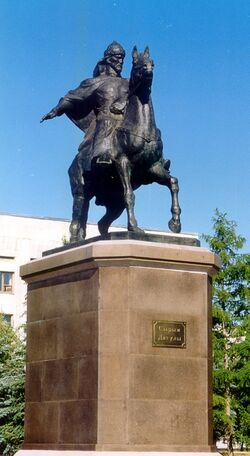
Since pre-revolutionary times, only the rotunda installed under A.D. Stolypin has been preserved in Uralsk. Once it housed a bust of Tsarevich Nikolai Alexandrovich , the son of Emperor Alexander II, who bore the title of ataman of all Cossack troops, who died in 1865.
In 1891, at the burial site of the Cossacks [38] , screwed up by Kochkin [39] In 1803, according to the fashion of those years, the Triumphal Arch was installed in honor of the 300th anniversary of the service of the Army to the Tsar and in honor of the arrival of the heir, Nikolai Alexandrovich . The Red Gate, as they were called in the city, was destroyed in the same 30s of the 20th century.
During the Soviet period, monuments to Lenin with an outstretched hand, Stalin, busts of Civil War participants associated with Uralsk - Chapaev and Furmanov, and a bust of Kirov in the city park that long bore his name were erected in the city . At the moment, all of them are on display in one of the alleys of the park, except for the monument to Stalin, which was demolished during the years of the fight against the cult of personality.
Later, in the 1980s, another monument to V.I. Chapaev was erected on the station square, on a horse, in a fluttering cloak and with a saber in his hand.
Another remarkable monument associated with the period of the Civil War is dedicated to the young fighter Misha Gavrilov. In the post-Soviet years, there were calls to demolish this “monument to a dead horse,” but it survived. Now the monument is located opposite the Military Technical School.
Among the monuments to participants in the Great Patriotic War is a monument to three heroines Manshuk Mametova , Aliya Moldagulova and Khiuaz Dospanova , and a bust of Marshal G. K. Zhukov . For the 40th anniversary of the Victory in 1985, a memorial was erected on the banks of the Urals with an Eternal Flame and a stele, portraits of Heroes of the Soviet Union from Uralsk and the region, and a bas-relief with a list of all the dead Urals residents. Later, a list of Ural residents who died in Afghanistan was added to them.
During the years of Kazakhstan's independence, monuments to Pushkin, Sholokhov, the Kazakh poet and thinker Abai and the leader of the anti-government uprising of the late 18th century Syrym Datov , and local history writer N. Savichev appeared in Uralsk. In the depths of the Khan's Grove, in the shadow of an overgrown alley, there is an obelisk from tsarist times with an inscription on it that says that at this place the kings took the oath from the khans of the inner horde.
الرياضة
FC Akzhayik are a Kazakhstani football club based in Petr Atoyan Stadium.
Bandy is the principal sport in the city. Akzhayik Sports Club, based in the Yunost Stadium, is the only professional team in the country and plays in the second highest division of Russia.[5] In September 2017, the Kazakhstan Bandy Federation bought the club.[6]
The city sent a team to the Spartakiade 2009 and the finished second.[7] All the players of the Under-23 national team in the 2013–14 season came from Oral.[8] After the Kazakhstan national bandy team took the gold medal at the 2011 Asian Winter Games, the team came back to Oral in triumph.[9]
المراجع
- ^ "Алматы қаласыАлмалы ауданыӘкімінің аппараты". www.almaly.almaty.kz.
- ^ أ ب "Население Республики Казахстан" (in Russian). Департамент социальной и демографической статистики. Retrieved 8 December 2013.
{{cite web}}: CS1 maint: unrecognized language (link) - ^ КЛИМАТ ОРЕНБУРГА (in الروسية). Погода и климат. Retrieved 8 November 2021.
- ^ "Uralsk (Oral) Climate Normals 1961-1990". National Oceanic and Atmospheric Administration. Retrieved 25 November 2016.
- ^ "Akzhayik / LiveTV". www.livetv.ru. Retrieved 16 April 2018.
- ^ "Google Translate". translate.google.co.uk. Retrieved 16 April 2018.
- ^ [1][dead link]
- ^ "Google Translate". translate.google.com. Retrieved 16 April 2018.
- ^ Video from the triumphant homecoming Archived 2013-12-02 at the Wayback Machine
وصلات خارجية
- "Uralsk, Kazakhstan". NASA Earth Observatory. Archived from the original on 2006-10-01. Retrieved 2006-05-01.
- Pages using gadget WikiMiniAtlas
- CS1 uses الروسية-language script (ru)
- CS1 الروسية-language sources (ru)
- Articles with dead external links from September 2018
- Articles with hatnote templates targeting a nonexistent page
- Short description is different from Wikidata
- Articles containing قزخ-language text
- Articles containing روسية-language text
- Coordinates on Wikidata
- Infobox mapframe without OSM relation ID on Wikidata
- Pages using Lang-xx templates
- Oral, Kazakhstan
- Cities and towns in Kazakhstan
- Populated places in West Kazakhstan Region
- Ural Oblast (Russian Empire)
- Populated places established in 1613
- 1613 establishments in Russia
- Transcontinental cities
- صفحات مع الخرائط




